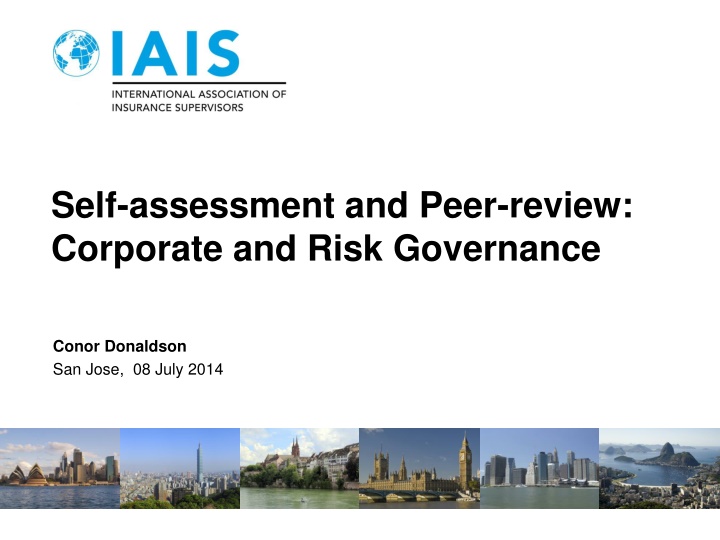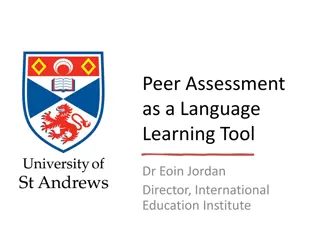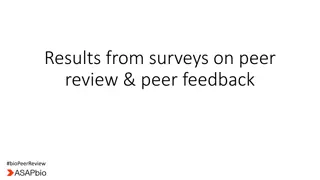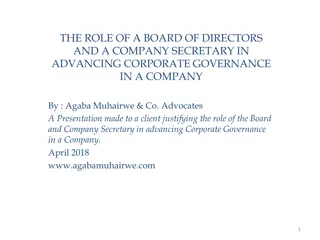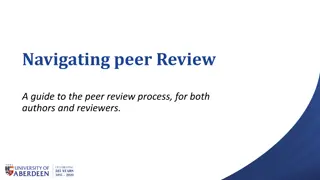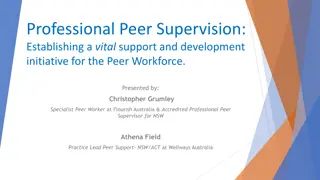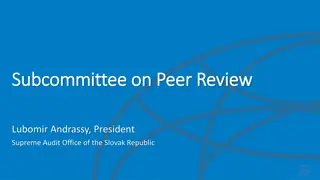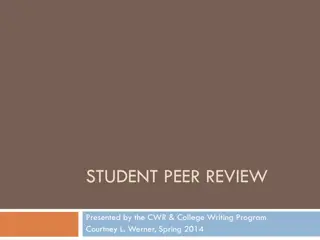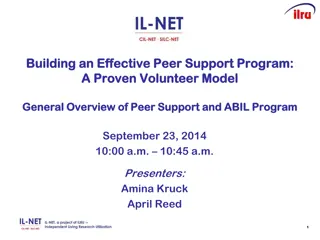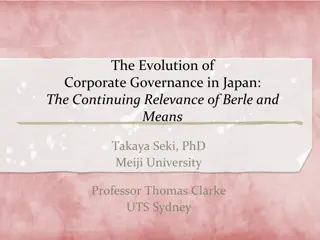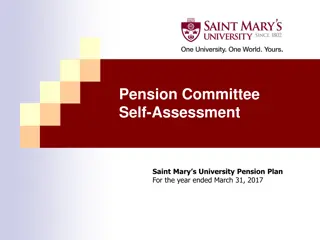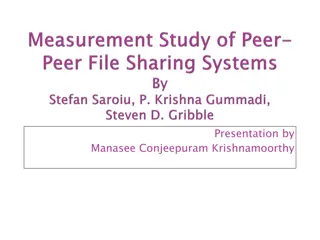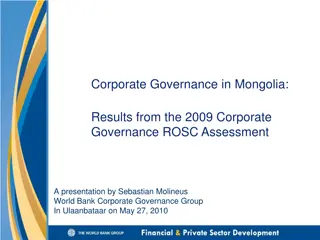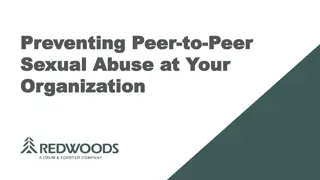Self-Assessment and Peer Review in Corporate Governance
Process and importance of self-assessment and peer review in corporate and risk governance, focusing on standards observance, expert group input, questionnaire development, and ratings generation.
Download Presentation

Please find below an Image/Link to download the presentation.
The content on the website is provided AS IS for your information and personal use only. It may not be sold, licensed, or shared on other websites without obtaining consent from the author.If you encounter any issues during the download, it is possible that the publisher has removed the file from their server.
You are allowed to download the files provided on this website for personal or commercial use, subject to the condition that they are used lawfully. All files are the property of their respective owners.
The content on the website is provided AS IS for your information and personal use only. It may not be sold, licensed, or shared on other websites without obtaining consent from the author.
E N D
Presentation Transcript
Self-assessment and Peer-review: Corporate and Risk Governance Conor Donaldson San Jose, 08 July 2014
Outline Background on Self Assessment and Peer Review Self Assessment and Peer Review ICP 5: Suitability of Persons ICP 7: Corporate Governance ICP 8: Risk Management and Internal Controls General Conclusions 2
IAIS Self Assessment and Peer Review Process Actual observance of international standards a key theme post financial crisis - Self assessment and peer review promise to Financial Stability Board (FSB) Objective - Seeking a process that: Gives independent and consistent assessment of observance Is manageable from a member and secretariat resource perspective Adds value for members identifies gaps and feeds into capacity building or reform initiatives Provides value to the IAIS feedback into standard setting Does not unduly duplicate existing assessments at FSB and FSAP level 3
IAIS Self Assessment and Peer Review Process Considering input from: - IAIS Subcommittees & Committees - Environmental assessment - FSB coordination and other topical suggestions - WB and IMF views - Feedback from FSAPs SOSC makes a recommendation, scheduling, sequencing, grouping topics SOSC establishes Expert Group for the topic area Topic Selection Questionnaire Development Review of Responses Reporting 4 4
IAIS Self Assessment and Peer Review Process Questionnaire drafted by specialist then further developed and completed by Expert Group IT Tool developed to take conditions in earlier responses into account reducing respondent burden Tested on volunteer jurisdictions (determined by Expert Group) for clarity and correct coding Topic Selection Questionnaire Development Review of Responses Reporting 5 5
IAIS Self Assessment and Peer Review Process Topic Selection Tool generates ratings horizontally and vertically Horizontal review process enhances consistency in ratings Vertical review identifies deficiencies particular to supervisors Questionnaire Development Review of Responses Reporting 6
IAIS Self Assessment and Peer Review Process Aggregate and individual reports produced Draft individual reports produced. Sent to jurisdictions for review, factual corrections and authority s comments then finalized Individual reports are not published by the IAIS but can be published or shared with others by the authority Topic Selection Questionnaire Development Review of Responses Reporting 7
Outline Background on Self Assessment and Peer Review Self Assessment and Peer Review ICP 5: Suitability of Persons ICP 7: Corporate Governance ICP 8: Risk Management and Internal Controls General Conclusions 8
ICP 5: Suitability of Persons The Supervisor requires the following people to be and to remain suitable to fulfil their respective roles: Board Members, Senior Management, Key Persons in Control Functions; and Significant Owners of an insurer. 9
ICP 5: Suitability of Persons General Observations: Suitability requirements include competency and integrity requirements for Board members, Senior Management and Key People in Control Functions. For Significant Owners they require the person to be financially sound and have integrity. Board Members, Senior Management, Key Persons in Control Functions: Indicators: relevant work experience, formal qualifications, absence of criminal record, financial conduct, supervisory record, behavioral conduct. Significant Owners: - - Indicators: current and future access to capital, creditworthiness, general integrity. Assessment should not be limited to the licensing stage but should extend to ongoing operations (supervision) of the insurer. The rigor of the assessment should be commensurate with the degree of influence of the person. Assessment may require exchanging information with other authorities including in foreign jurisdictions. 10
ICP 5: Suitability of Persons 1. The legislation identifies which persons meet suitability requirements. 2. The Supervisor requires that in order to be suitable, Board Members, Senior Management and Key Persons in Control Functions possess competence and integrity to fulfil their roles. Significant Owners are required to have the financial soundness and integrity necessary to fulfil their roles. 3. The Supervisor requires the insurer to demonstrate initially and thereafter, when requested by the supervisor, the suitability of Board Members, Senior Management, Key Persons in Control Functions and Significant Owners. The suitability requirements and the extent of review required depend on the person s position and responsibility. 11
ICP 5: Suitability of Persons 4. The Supervisor requires to be notified by insurers of any changes in Board Members, Senior Management, Key Persons in Control Functions and Significant Owners, and of any circumstances that may materially adversely affect the suitability of its Board Members, Senior Management, Key Persons in Control Functions and Significant Owners. 5. The Supervisor takes appropriate action to rectify the situation when Board Members, Senior Management and Key Persons in Control Functions or Significant Owners no longer meet suitability requirements. 6. The Supervisor exchanges information with other authorities inside and outside its jurisdiction where necessary to check the suitability of Board Members, Senior Management, Key Persons in Control Functions and Significant Owners of an insurer. 12
ICP 5: Suitability of Persons ICP 5 was not significantly revised in 2011, though it did contain some important additions, such as assessments regarding Key Persons in Control Functions. Observe d Largely Observe d Partly Observe d Not Not Total Index Observe d Assessed ICP 5 Totals 10 45 9 0 5 69 6.5 ICP5 in Americas 0 10 3 0 0 13 6.3 General Comments: some jurisdictions do their suitability assessments at the time of licensing applications and may not assess significantly thereafter. a number of supervisors do not yet assess the suitability of Key Persons in Control Functions, which may be understandable given that it is a new concept in some jurisdictions. practices vary with respect to the use of financial indicators in assessing the suitability of Significant Owners. 13
ICP 5: Suitability of Persons Standard 5.1 states that legislation identifies which persons meet suitability requirements, but does not specify which persons should meet such requirements, so it could be assessed as Observed even if the scope of the legislation could be very limited. Observed Largely Observed Partly Observed Not Not Total Index Observed Assessed Standard 5.1 Total 44 17 6 2 0 69 8.4 Results in Americas 10 4 0 0 0 14 9.1 14
ICP 5: Suitability of Persons Standard 5.3 suitability assessments are necessary on appointment and on- going assessments. A number of supervisors do not do this. Why are on-going assessments important? What should supervisors look for in on-going assessments? What supervisory interventions should be considered if concerns are identified in on-going suitability assessments? Observed Largely Observed Partly Observed Not Not Assessed Total Index Observed Results by Nature of Jurisdiction 1 58 9 0 1 69 6.6 Results in Americas 0 12 1 0 1 14 6.8 15
ICP 7: Corporate Governance The supervisor requires insurers to establish and implement a corporate governance framework which provides for sound and prudent management and oversight of the insurer s business and adequately recognizes and protects the interests of policyholders. General Observations: Corporate governance refers to the strategies, policies, processes and controls through which an insurer is managed and controlled. Insurance supervisors, as part of their ongoing supervisory review process, should require insurers to demonstrate the adequacy and effectiveness of their corporate governance framework. The new ICP refines and expands previous requirements into ten standards. They place particular emphasis on the composition and responsibilities of the Board. The application of these standards should, however, reflect the nature, scale and complexity of the business of the insurer. The following describes the major elements included in the standards. 16
ICP 7: Corporate Governance Responsibilities of the Board: Set and oversee implementation of business objectives and strategies in line with the insurer s long term interests and viability Clearly define the roles of the Board, Senior Management and Key Persons in Control Functions so that the oversight and management functions are separated. Provide oversight of the Senior Management. Provide oversight in the design and implementation of sound risk management and internal controls. Adopt and oversee implementation of a remuneration policy that does not induce inappropriate risk taking and is in line with the long term interests of the insurer. Ensure that there are reliable financial reporting and audit processes. Ensure that there are systems and controls for timely and effective communication of governance issues with the supervisor and relevant stakeholders. 17
ICP 7: Corporate Governance Structure and Governance of the Board: Appropriate number and mix of knowledge, skills and expertise? Appropriate internal governance practices and procedures that safeguard its efficiency, objectivity and independence? Adequate powers and resources to carry out its duties effectively? Duties of Board Members: Act in good faith, honestly, reasonably and in the best interests of the insurer and policyholders? Exercise due care and diligence? Exercise independent judgment and objectivity in decision making? Avoid conflicts of interest with those of the insurer and policyholders? Duties of Senior Management: Execute day-to-day operations in accordance with the Board-approved strategies, policies and procedures? Promote a culture of sound risk management, compliance and fair treatment of customers? Provide Board with adequate and timely information on performance and risk? Provide stakeholders and supervisor with relevant information? 18
ICP 7: Corporate Governance ICP 7 was significantly revised in 2011 and observance was lower across the participating supervisors. Observed Largely Observed Partly Observed Not Not Total Index Observed Assessed ICP 7 Total Participation 19 30 11 0 9 69 7.4 ICP 7 in Americas 2 10 0 0 2 14 7.5 General Comments Supervisors from FSB Member jurisdictions had, in general, higher levels of observance. In many jurisdictions, corporate governance requirements are defined, at least in part, in legislation other than insurance law. One of the primary challenges for observance of this ICP is reactive or incomplete supervisory practices. 19
ICP 7: Corporate Governance Standard 7.6 The level of observance of this standard, which relates to remuneration, is low and particularly low in some regions. This is a new standard and it is not yet clear that Supervisors have the power to establish expectations respecting remuneration or have communicated those expectations to insurers. Does your jurisdiction require directors to adopt and oversee the implementation of an effective remuneration plan? How do you ensure a board is meeting this responsibility? Observed Largely Observed Partly Observed Not Not Total Index Observed Assessed Total participating authorities 16 19 24 9 1 69 5.7 Results in Americas 1 4 8 1 0 14 5.0 20
ICP 8: Risk Management and Internal Controls The Supervisor requires an insurer to have, as part of its overall corporate governance framework, effective systems of risk management and internal controls, including effective functions for risk management, compliance, actuarial matters and internal audit. General Observations: The risk management and internal control system of an insurer is comprised of its strategies, policies, processes and controls to identify, assess, monitor, manage and report risks that it may be exposed to at a legal entity or group level. Risk management and internal control is part of the fabric of insurer governance. The systems must include a risk management function, a compliance function, an actuarial function and an internal audit function. These are expected to be commensurate with the nature, scale and complexity of their business. The new ICP refines and expands previous requirements (found in the old ICPs 10, 18 and 19) into seven standards. 21
ICP 8: Risk Management and Internal Controls 1. The supervisor requires the insurer to establish, and operate within, effective systems of risk management and internal controls. 2. The supervisor requires the insurer to have effective control functions with the necessary authority, independence, and resources. 3. The supervisor requires the insurer to have an effective risk management function capable of assisting the insurer to identify, assess, monitor, manage and report on its key risks in a timely way. 4. The supervisor requires the insurer to have an effective compliance function capable of assisting the insurer to meet its legal and regulatory obligations and promote and sustain a corporate culture of compliance and integrity. 22
ICP 8: Risk Management and Internal Controls 5. The supervisor requires that there is an effective actuarial function capable of evaluating and providing advice to the insurer regarding, at a minimum, technical provisions, premium and pricing activities, and compliance with related statutory and regulatory requirements. 6. The supervisor requires the insurer to have an effective internal audit function capable of providing the Board with independent assurance in respect of the insurer s governance, including its risk management and internal controls. 7. The supervisor requires the insurer to retain at least the same degree of oversight of, and accountability for, any outsourced material activity or function (such as a control function) as applies to non-outsourced activities or functions. 23
ICP 8: Risk Management and Internal Controls ICP 8 was significantly revised in 2011, with the new Standards being much more explicit. Observed Largely Observed Partly Observed Not Not Total Index Observed Assessed Total participating authorities 16 37 9 0 7 69 7.3 ICP 8 in Americas 2 10 0 0 2 14 7.5 General Comments Legislative frameworks should ensure supervisors have the power to require insurers to have all control functions, and that these functions have the necessary resources, independence, and authority. Some supervisors may require one control function (eg, Internal Audit), while not requiring a Risk Management or a Compliance Function. In many jurisdictions internal control requirements are defined, at least in part, in legislation other than insurance law. Supervisors should assess risk management and internal controls proactively, not just when problems are identified. 24
ICP 8: Risk Management and Internal Controls Standard 8.2, addressing the authority, independence and resources of control functions had the highest number of supervisors with an assessment lower than Observed . Why is it important to ensure that authority, independence and resources be in legislation? How do you supervise to determine whether a control function has authority or independence? How do you measure resource sufficiency? Observed Largely Observed Partly Observed Not Not Total Index Observed Assessed Total participating authorities 25 25 14 1 4 69 7.4 Results in Americas 5 2 6 0 1 14 6.8 25
Outline Background on Self Assessment and Peer Review Self Assessment and Peer Review ICP 5: Suitability of Persons ICP 7: Corporate Governance ICP 8: Risk Management and Internal Controls General Conclusions 26
General Conclusions Approximately 69 jurisdictions completed this SAPR, with strong regional distribution of participants. In general, observance of the ICPs and standards is high. Some jurisdictions have appropriate regulatory frameworks, have policies and procedures in place, but supervision is reactive, not proactive. Some jurisdictions rely on legislative frameworks that are not insurance specific eg, existing corporate law or securities law. Some of the shortcomings relate to standards that were new or were considerably revised in 2011. Implementation is still a challenge. 27
Contact information Conor Donaldson Member of the Secretariat Telephone: + 41 61 280 8602 Mobile: + 41 76 350 8602 Email: conor.donaldson@bis.org Skype: conordonaldson c/o Bank for International Settlements Centralbahnplatz 2 CH-4002 Basel Switzerland Website: www.iaisweb.org 28
